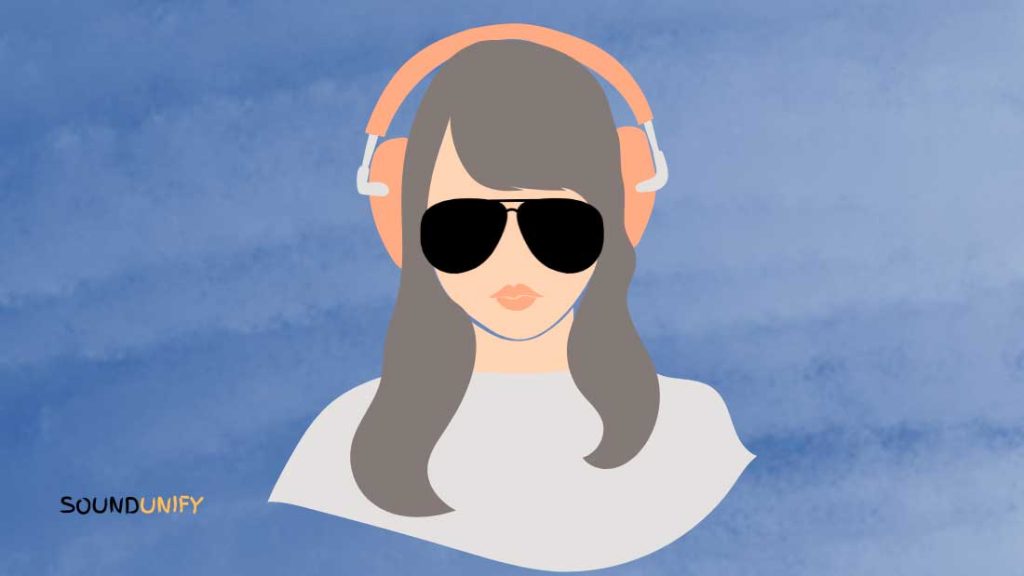Are over-ear headphones good with glasses? Yes, over-ear headphones can be comfortably used with glasses. However, the right fit is crucial to avoid discomfort.
I’ve often wondered if my love for music and my need for glasses could coexist comfortably, especially when it comes to using over-ear headphones. It turns out the key lies in finding the perfect pair that accommodates both.
Let me share my journey. Initially, I faced the common issue many glasses wearers encounter: the pressure between the headphones and the arms of the glasses, leading to discomfort or even headaches. This problem often arises from headphones with tight clamping force or insufficient padding.
But, as I explored further, I discovered headphones designed with softer, more pliable ear pads and adjustable headbands. These features significantly reduce the pressure on the glasses’ arms. Moreover, some models even come with special indentations to accommodate the arms of glasses, ensuring a pain-free listening experience.
In this blog, I’ll discuss details of the factors that make over-ear headphones and glasses-friendly and share tips on what to look for when shopping for your next pair.
What Are Over-Ear Headphones?

Over-ear headphones are a popular style on the market today. They are typically made with a tight-fitting cup that rests over your ears. This design is very comfortable and allows you to wear them for long periods without discomfort.
Additionally, over-ear headphones can block out ambient noise, making them perfect for noisy environments. However, before purchasing over-ear headphones, testing them in a quiet environment is important to ensure they are comfortable.
And if you’re looking for a design that is both comfortable and noise-canceling, over-ear headphones are the perfect option for you!
Challenges for Glasses Wearers

For glasses wearers, the quest for the perfect over-ear headphones is often riddled with comfort problems. The primary challenge lies in the pressure exerted on the temples and ears by the headphones’ bands and cups. This pressure, although seemingly trivial initially, can escalate into painful discomfort over extended listening periods. Adjustment struggles are real; finding that sweet spot where the headphones don’t clash with the glasses’ arms seems more like a chore than a one-time setup.
Moreover, the temples of glasses, particularly those of a thicker make, can disrupt the seal that over-ear headphones are designed to create around the ear. This disruption can lead to a compromised sound experience, as external noises creep in while the fullness of bass escapes. The glasses become a barrier to immersion, a constant reminder to the wearer of the battle between auditory bliss and physical comfort.
Another under-discussed but critical issue is the wear and tear on the glasses and headphones. The constant friction and pressure can lead to weakened frames, distorted ear pads, and, in some cases, scratches on the lenses or the headphone surface. The longevity of your accessories is at stake, making the challenge not just about immediate comfort but also about sustainable usage.
In this tightrope between comfort and quality, glasses wearers often sacrifice shortened listening sessions, constant readjustments, or settle for less-than-ideal audio quality. Pursuing a pain-free listening experience remains a significant challenge, urging individuals to look beyond sound quality and price when selecting their ideal pair of over-ear headphones.
How Over-Ear Headphones Solve Headphones with Glasses Problems?

Over-ear headphones present several solutions to the common problems glass wearers face, offering a blend of comfort and quality audio experience.
- Larger Ear Cups for Reduced Pressure: The most significant advantage of over-ear headphones is their large, encompassing ear cups. Unlike on-ear designs, these cups go around the ear, greatly reducing the pressure on the temples and ears. This design minimizes the direct contact and friction between the headphones and the glasses, alleviating discomfort during prolonged use.
- Soft, Thick Padding for Comfort: Over-ear headphones typically feature thick, soft padding around the ear cups. This padding acts as a cushion between the headphones and the head, distributing pressure more evenly and lessening the impact on the temples where the glasses rest. Memory foam, in particular, is effective as it contours to the shape of the head and glasses, providing a more personalized fit.
- Adjustable Headbands for a Custom Fit: Most over-ear headphones come with adjustable headbands that can be extended or shortened to fit different head sizes. This adjustability is crucial for glasses wearers as it allows them to find a comfortable position where the headphones sit securely without exerting excessive pressure on the glasses.
- Swivel and Tilt Features for Flexibility: Some high-end over-ear headphones offer swivel and tilt features in their ear cups. This flexibility enables the headphones to adapt to the shape of the user’s head and the position of the glasses, further enhancing comfort.
- Sound Isolation and Quality: Over-ear headphones are known for their superior sound isolation, which benefits glasses wearers. The design helps create a seal around the ear, preventing sound leakage and maintaining audio quality, even when the fit is slightly adjusted to accommodate glasses.
- Heat and Sweat Management: Many over-ear headphones are designed with materials that mitigate heat and sweat, which can concern glasses wearers. Breathable fabrics and ventilated designs help keep the ears cool, reducing the likelihood of fogging glass lenses during extended listening sessions.
- Durability and Ease of Maintenance: The robust build of over-ear headphones often translates to better durability, an important factor for users who need to adjust their headphones frequently due to glasses. Additionally, many models feature removable and washable ear pads, making it easier to maintain hygiene and extend the life of the headphones.
When Buying Headphones with Glasses, Try Over-Ears?

Over-ear headphones seal off the ear canal better, making them more comfortable to wear with glasses. The ear cups are usually adjustable to fit you and your glasses comfortably.
Wearing glasses wouldn’t create a pain sandwich like on-ear headphones make by crushing the plastic arms between your skull and ear lobes.
Additionally, over-ear headphones usually have a better seal and provide a more immersive sound experience when compared to on-ear models.
So, if you’re looking for the best overall audio quality, go for an audiophile-grade headphone like those offered by OneOdio, Sony, or Sennheiser. They’ll cost more upfront but will be worth it in the long run.
Why Does Wearing Glasses with Headphones Hurt?

Listening to music or audiobooks can be discomforting if you wear headphones with glasses. The best way to avoid this discomfort is to try wearing more oversized, soft ear cups of over-ear headphones instead of in-ear.
The ear cups on over-ear headphones are often too big and can fit into your skull. However, in-ear headphones can fit too tightly, preventing air from circulating freely. That can lead to pain in the ear, ear fatigue, and headaches.
If you experience pain, taking a break from your audio consumption and seeing a doctor for further evaluation is essential.
Could Over-Ear Headphones Put Pressure on The Glass Temple?
Over-ear headphones can put extra pressure on your ears, which may not be comfortable with glasses. Headphones with high clamping force, smaller ear cups, ear padding made with rough or hard cushions, or smaller headbands according to your skull size can pressure the glass temple.
So, if you wear glasses, it’s best to use in-ear or over-ear headphones instead of regular earbuds. Alternatively, you can still listen to music and take phone calls while wearing over-ear headphones, but it may be more comfortable.
Could Narrow Earpads Be the Problem?
Yes, of course, narrow earpads can be a problem for those people who wear glasses. Many over-ear headphones have narrow earpads that can be uncomfortable with glasses. If so, try to pick headphones with bigger ear cups and breathable ear pads instead.
They fit more securely in the ear and don’t tend to move around as much, making them a better option for glasses wearers.
Additionally, trying the headphones before purchasing is always a good idea. This way, you’ll be sure they’ll work well with your eyeglasses.
If over-ear headphones are the only option, try wearing them for a few hours before putting them on for an extended period. This way, you can determine if they’re comfortable enough or not.
How Do You Wear Over-Ear Headphones Comfortably with Glasses?

Over-ear headphones are popular for people who wear glasses, so don’t be discouraged if they’re uncomfortable to wear at first. With a little trial and error, you’ll soon find the perfect fit.
- First and foremost, arrange the ear cups to sit low on your neck- this will minimize contact between the headphones and your glasses.
- Ensure the band is wide enough to fit around your head comfortably- this will help keep pressure off your temples while wearing them.
- Try these tips to make over-ear headphones more comfortable with glasses:
- Fit the headphones snugly without being too tight.
- If they are too tight, they can cause pain in your ears and headaches when you’re wearing them for long periods.
1. Wearing Glasses with Thinner Frames
Wearing headphones with thinner frames is more comfortable than thicker frames. Not everyone is comfortable wearing over-ear headphones with thicker frames. Thinner frames put little pressure on your scalp compared to thicker frames.
So you’ll need to find the right pair that fits comfortably on your ears and glasses. You also need to ensure the band sits low on your head. So it does not obstruct your vision.
2. Adjusting Your Headphones for Looseness
Wearing headphones for long periods can lead to headaches and other discomforting symptoms over time. Here are a few tips on how to adjust headphones so that you can wear them comfortably:
- Ensure the headphones are not too tight or restrictive against your ears and head. They should fit snugly but not feel uncomfortable or painful when worn for an extended time.
- If you’re wearing over-ear headphones, it’s important to adjust them. So they fit well with your glasses- by adjusting the band or ear cups accordingly.
That will ensure optimal sound quality while avoiding any accidental collisions between glasses and microphones built into some headphone models like OneOdio Pro 50. It is padded with swivelling ear cups and is perfect for gamers, DJs, or professional studios.
2. Slide Tissue Paper Between Your Glasses and Head
While using over-ear headphones and glasses, sliding tissue paper between them can make them more comfortable. When you are ready to put the headphones back on, gently push the tissue paper back into place, and your glasses should stay in place. It will prevent your ear and scalp from hurting from the frames of the glasses.
3. Find a Select Over-Ear Headphones
When wearing headphones with glasses, over-ear headphones are the go-to choice. Their design, featuring large cups that fully enclose the ears, offers numerous benefits:
- Encompassing Ear Cups: They provide ample space around the ears, reducing direct pressure on the frames of your glasses.
- Reduced Clamping Force: Over-ear headphones often have a more relaxed fit, minimizing the discomfort against the temples.
- Improved Sound Quality: The larger design allows for better sound quality, enhancing your audio experience.
- Versatile for Different Ear Sizes: They comfortably cater to a wide range of ear sizes, making them a universal choice.
4. Look for Soft, Thick Padding
The comfort of headphones significantly hinges on the quality and softness of the padding. When selecting headphones for use with glasses, consider these points:
- Cushioning Effect: Soft, thick padding, especially memory foam, provides a cushion-like effect, reducing pressure.
- Conforms to Head Shape: This type of padding molds to the shape of your head and glasses, offering a personalized fit.
- Even Pressure Distribution: Thick padding ensures the pressure is distributed evenly, lessening discomfort.
- Heat and Sweat Absorption: Quality padding can absorb excess heat and sweat, adding to overall comfort.
- Noise Isolation: Besides comfort, thicker padding also aids in better noise isolation, enhancing the audio experience.
5. Combined Headphones and Glasses that Complement Each Other
Finding headphones and glasses that complement each other can be tricky, especially when looking for a new pair. However, finding the perfect accessory set will be easier with a few tips in mind.
When it comes to sunglasses, it is best to find frames with similar dimensions to your glasses. This way, they’ll look good together once you put them on.
Try to find glasses with thinner frames and headphones with thicker ear padding. Trying on different pairs of headphones and glasses can be helpful to see which one fits best. Once you find the pair that works best for your lifestyle, it’ll be easier to stick with them in the future.
6. Gentle Positioning of Glasses
Gentle positioning of glasses while wearing headphones is important to ensure comfort and prevent any potential discomfort or damage to both the glasses and headphones. Here are some tips for achieving this:
- Position Glasses Arms Over the Padding: Try to position the arms of your glasses to rest over the padding of the headphones. This can help in reducing direct pressure on the temples and ears.
- Adjust the Glasses Arms Carefully: Be gentle when adjusting the arms of your glasses. Avoid bending them too much, which can lead to misalignment or breakage.
- Find the Right Balance: Aim for a balance where your glasses are secure but not pressed too tightly against your head. The headphones should not push the glasses down or cause them to tilt uncomfortably.
- Mind the Ear Cups: Ensure that the ear cups of the headphones are not pressing your ears against the frames of your glasses. This can be uncomfortable and may also impact the sound quality.
By paying attention to these aspects, you can wear your headphones and glasses together more comfortably. Enhancing your overall audio experience without compromising comfort or damaging your glasses.
FAQ
Q. Which types of glass should I use when wearing over-ear headphones?
When choosing ear headphones, finding a pair that fits snugly on your head without them falling off or causing discomfort is essential. Consider headphones with bigger ear cups that will fit over your eyeglasses.
Additionally, make sure the size and shape of the headphone cup are comfortable around your ears without causing pain or pressure points.
Q. Can I wear my over-ear headphones while working out or doing other physical activity?
Yes, you can wear over-ear headphones while working out or doing other physical activity.
Many people enjoy listening to audiobooks or music on headphones during workouts or other activities because they provide excellent sound quality and less distraction.
When choosing headphones, consider sound quality, design, price, and comfort factors to get the best experience, like Sony wh-1000xm4.
It has dual noise sensor technology with touch sensor controls to provide ultimate comfort.
Q. How do I know if my over-ear headphones are comfortable with glasses?
Generally, over-ear headphones are comfortable with glasses on. If you’re still having difficulty wearing headphones with glasses, you may need to go for different models of headphones or switch to regular earbuds instead of over-ear ones.
You can also try wearing headphones with larger ear cups, thick padding, and low clamping force, as these tend to be more comfortable.
Conclusion
In short, trying out the headphones physically and wearing your glasses is always recommended to find out which one is comfortable for you.
If buying online, check out the reviews and the user’s experience with the headphones you want.
Also, you can read about the real-life experiences of people who wear glasses with headphones, which will help you decide.
James Dimento is a Chief-in-Editor of SoundUnify. He is a headphone enthusiast and creative writer passionate about audio technology. He has three years of experience writing about headphones and sound quality and is responsible for creating reviews and taking care of all administration.
